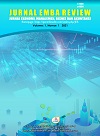Development of Farmer Exchange Rates by Sub-Sector in North Sumatra
DOI:
https://doi.org/10.53697/emba.v2i2.1098Keywords:
Farmer Exchange Rate, Agriculture Sub SectorAbstract
The purpose of this study is to determine the development of farmer exchange rates according to the sub-sectors in North Sumatra. In this study the data used were secondary data, namely information obtained from the Central Bureau of Statistics (BPS) and the type of research used in this study was a type of qualitative descriptive research using the library study method. The results of this study are that the farmer's exchange rate is a method for assessing the ability of farmers to exchange agricultural goods for household goods and services as well as agricultural goods. The sub-sectors of Farmers' Terms of Trade (NTP) include food crops, horticulture, smallholder plantation crops, livestock and fisheries. And the conclusion of this study is that the FTT sub-sectors of food crops, horticulture, and smallholder plantation crops have not been able to meet the needs of farmer households because these three sub-sectors have a smaller value when compared to the NTP of the livestock and fisheries sub-sectors. Therefore, farmers who only depend on plants cannot be said to be able to rely solely on agriculture.
Downloads
Published
How to Cite
Issue
Section
License
Copyright (c) 2022 Anisah Salsabila Nasution, Auliya Ahmad Suhardi , Indri Andini , Samsi Efendi , Sari Wulandari

This work is licensed under a Creative Commons Attribution-ShareAlike 4.0 International License.













